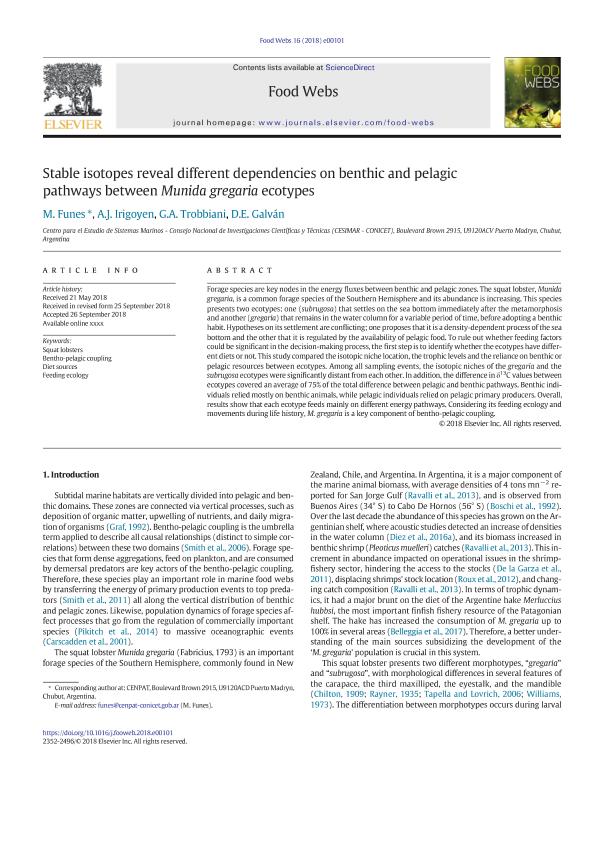Mostrar el registro sencillo del ítem
dc.contributor.author
Funes, Manuela

dc.contributor.author
Irigoyen, Alejo Joaquin

dc.contributor.author
Trobbiani, Gastón Andres

dc.contributor.author
Galvan, David Edgardo

dc.date.available
2019-11-13T20:24:13Z
dc.date.issued
2018-12
dc.identifier.citation
Funes, Manuela; Irigoyen, Alejo Joaquin; Trobbiani, Gastón Andres; Galvan, David Edgardo; Stable isotopes reveal different dependencies on benthic and pelagic pathways between Munida gregaria ecotypes; Elsevier; Food Webs; 17; 12-2018; 1-9
dc.identifier.issn
2352-2496
dc.identifier.uri
http://hdl.handle.net/11336/88782
dc.description.abstract
Forage species are key nodes in the energy fluxes between benthic and pelagic zones. The squat lobster, Munida gregaria, is a common forage species of the Southern Hemisphere and its abundance is increasing. This species presents two ecotypes: one (subrugosa) that settles on the sea bottom immediately after the metamorphosis and another (gregaria) that remains in the water column for a variable period of time, before adopting a benthic habit. Hypotheses on its settlement are conflicting; one proposes that it is a density-dependent process of the sea bottom and the other that it is regulated by the availability of pelagic food. To rule out whether feeding factors could be significant in the decision-making process, the first step is to identify whether the ecotypes have different diets or not. This study compared the isotopic niche location, the trophic levels and the reliance on benthic or pelagic resources between ecotypes. Among all sampling events, the isotopic niches of the gregaria and the subrugosa ecotypes were significantly distant from each other. In addition, the difference in δ13C values between ecotypes covered an average of 75% of the total difference between pelagic and benthic pathways. Benthic individuals relied mostly on benthic animals, while pelagic individuals relied on pelagic primary producers. Overall, results show that each ecotype feeds mainly on different energy pathways. Considering its feeding ecology and movements during life history, M. gregaria is a key component of bentho-pelagic coupling.
dc.format
application/pdf
dc.language.iso
eng
dc.publisher
Elsevier

dc.rights
info:eu-repo/semantics/openAccess
dc.rights.uri
https://creativecommons.org/licenses/by-nc-nd/2.5/ar/
dc.subject
BENTHO-PELAGIC COUPLING
dc.subject
DIET SOURCES
dc.subject
FEEDING ECOLOGY
dc.subject
SQUAT LOBSTERS
dc.subject.classification
Ecología

dc.subject.classification
Ciencias Biológicas

dc.subject.classification
CIENCIAS NATURALES Y EXACTAS

dc.title
Stable isotopes reveal different dependencies on benthic and pelagic pathways between Munida gregaria ecotypes
dc.type
info:eu-repo/semantics/article
dc.type
info:ar-repo/semantics/artículo
dc.type
info:eu-repo/semantics/publishedVersion
dc.date.updated
2019-10-22T15:34:18Z
dc.journal.volume
17
dc.journal.pagination
1-9
dc.journal.pais
Países Bajos

dc.journal.ciudad
Amsterdam
dc.description.fil
Fil: Funes, Manuela. Consejo Nacional de Investigaciones Científicas y Técnicas. Centro Científico Tecnológico Conicet - Centro Nacional Patagónico. Centro para el Estudio de Sistemas Marinos; Argentina
dc.description.fil
Fil: Irigoyen, Alejo Joaquin. Consejo Nacional de Investigaciones Científicas y Técnicas. Centro Científico Tecnológico Conicet - Centro Nacional Patagónico. Centro para el Estudio de Sistemas Marinos; Argentina
dc.description.fil
Fil: Trobbiani, Gastón Andres. Consejo Nacional de Investigaciones Científicas y Técnicas. Centro Científico Tecnológico Conicet - Centro Nacional Patagónico. Centro para el Estudio de Sistemas Marinos; Argentina
dc.description.fil
Fil: Galvan, David Edgardo. Consejo Nacional de Investigaciones Científicas y Técnicas. Centro Científico Tecnológico Conicet - Centro Nacional Patagónico. Centro para el Estudio de Sistemas Marinos; Argentina
dc.journal.title
Food Webs
dc.relation.alternativeid
info:eu-repo/semantics/altIdentifier/doi/http://dx.doi.org/10.1016/j.fooweb.2018.e00101
dc.relation.alternativeid
info:eu-repo/semantics/altIdentifier/url/https://www.sciencedirect.com/science/article/pii/S2352249618300272
Archivos asociados
